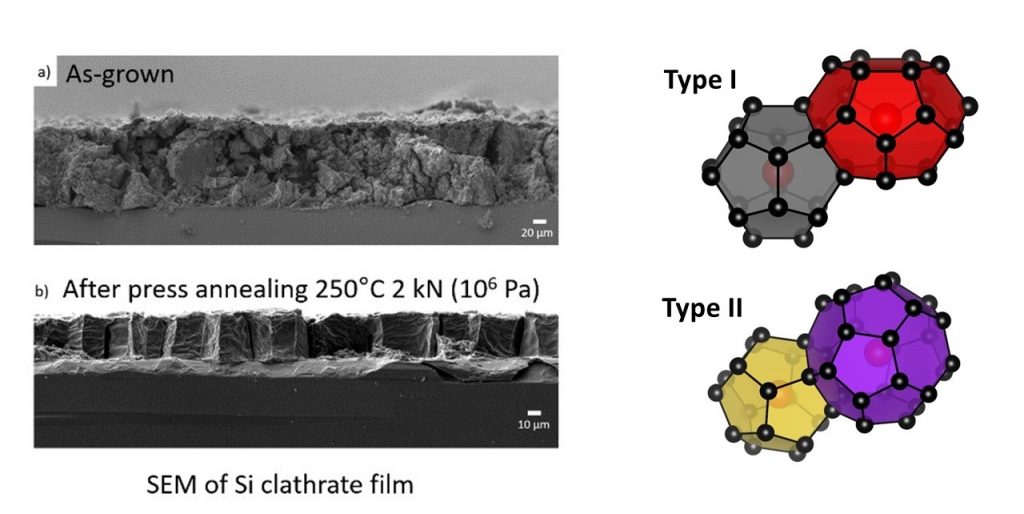Common forms of elemental silicon (mono-, multi-crystalline and amorphous) play a foundational role in the field of electronics and the underlying technologies are well mastered. Silicon is an element that is abundant, stable and non-toxic. Silicon clathrates are an exotic form of silicon, discovered in 1965, based as in fullerenes on hollow spheres of various size. The synthesis of clathrates in the form of films is not well mastered and presents technological bottlenecks that we aim to solve (integration into functional devices). ICube is one of the few laboratories that can elaborate such material in the form of films. The electronic and optical properties of these clathrates are strongly different to the “standard” silicon as they can provide a direct bandgap (for type II clathrates), paving the way for novel applications in electronics, optoelectronics and photovoltaics. We have demonstrated by Spectroscopic Surface Photovoltage that type II clathrates are a semiconductor in itself, distinct from diamond silicon. Not only the size of the clathrates but also the presence of doping atoms can dramatically modify their properties. Ion implantation available at ICube is used to modify the properties of the clathrates. Applications in sodium-ion batteries are also emerging for these materials.
More details on the ANR EXOSIL pages that are providing funding for this project.
[1] Silicon Clathrate Films for Photovoltaic Applications, T. Fix, R. Vollondat, A. Ameur, S. Roques, J.-L. Rehspringer, C. Chevalier, D. Muller, and A. Slaoui, J. Phys. Chem. C 124, 28, 14972–14977 (2020)
[2] Synthesis and characterization of silicon clathrates of type I Na8Si46 and type II NaxSi136 by thermal decomposition, R. Vollondat, S. Roques, C. Chevalier, J. Bartringer, J.-L. Rehspringer, A. Slaoui, T. Fix, Journal of Alloys and Compounds 903, 163967 (2022)
[3] Tunability of silicon clathrate film properties by controlled guest-occupation of their cages, R. Vollondat, D. Stoeffler, D. Preziosi, S. Roques, A. Slaoui, T. Fix, J. Chem. Phys. 158, 164709 (2023)
[4] Influence of Sodium Concentration on the Optoelectronic Properties of Silicon Clathrate Films, A. K. Bharwal, R. Vollondat, C. Tamin, S. Roques, J. Bartringer, D. Stoeffler, C. Chevalier, A. Dinia, A. Slaoui, and T. Fix, ACS Appl. Energy Mater. 7, 8554-8561 (2024)
[5] Comparative energy levels analysis of Type I and Type II silicon clathrate films, A. K. Bharwal, M. Hanauer, C. Tamin, R. Vollondat, S. Roques, J. Bartringer, D. Stoeffler, C. Chevalier, A. Dinia, A. Slaoui and T. Fix, MRS Adv. 9, 1685-1690 (2024)
[6] Enhancing Morphological and Optoelectronic Properties of Silicon Clathrate Films through Thermal Press Annealing and SF6 Treatment, A. K. Bharwal, J. P. Briggs, C. Tamin, M. Hanauer, R. Vollondat, J. Bartringer, S. Roques, C. Chevalier, A. Dinia, R. Collins, A. Slaoui and T. Fix, ACS Appl. Energy Mater. 8, 3, 1752-1758 (2025)
[7] Exploring the Potential of Silicon Clathrate Films with NiOx-Based Selective Contacts for Optoelectronic Devices, C. Tamin, A. K. Bharwal, C. Chevalier, A. Fave, E. Fourmond, S. Roques, A. Dinia, A. Slaoui, T. Fix, Advanced Materials Interfaces 12, e00301 (2025)
[8] Effect of hydrogenation on type II silicon clathrate films, M. Hanauer, A. K. Bharwal, Y. Tong, B. Aissa, C. Tamin, J. Bartringer, S. Roques, D. Muller, C. Chevalier, A. Dinia, A. Slaoui, T. Fix, Journal of Physics: Energy 7, 045019 (2025)
[9] Enhanced Optoelectronic Properties of Silicon Clathrate Films via Sodium Extraction by Vacuum Annealing, A. Bharwal, J. P. Briggs, C. Tamin, M. Hanauer, M. Lenertz, J. Bartringer, S. Roques, C. Chevalier, M. Gallart, P. Gilliot, M. Ziegler, A. Dinia, A. Slaoui, R. T. Collins, T. Fix, Phys. Status Solidi RRL e202500318 (2025)
[10] Fabrication and Optimization of Type II Silicon Clathrate Films, M.-C. Ettobi, C. Tamin, A. K. Bharwal, S. Roques, C. Chevalier, A. Slaoui, A. Dinia, A. Fave, E. Fourmond, D. Stoeffler, T. Fix, Journal of Visualized Experiments 224, e69215 (2025)

